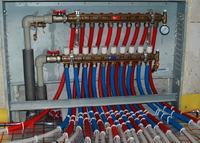Hello,
In the house, we have one manifold on each level, as in the picture below. In the upper part, we can remove the red caps and then we can twist or unscrew the valve. I have a few operational questions:
1. When one of the upper valves is turned off, the pipe with the red conduit cools down (i.e. we cut off hot water for a given loop). Changing the settings of this valve even for one loop affects the operation of other loops (although I do not change others).
2. What is this lower beam in the manifold for and how does it work?

In the house, we have one manifold on each level, as in the picture below. In the upper part, we can remove the red caps and then we can twist or unscrew the valve. I have a few operational questions:
1. When one of the upper valves is turned off, the pipe with the red conduit cools down (i.e. we cut off hot water for a given loop). Changing the settings of this valve even for one loop affects the operation of other loops (although I do not change others).
2. What is this lower beam in the manifold for and how does it work?



